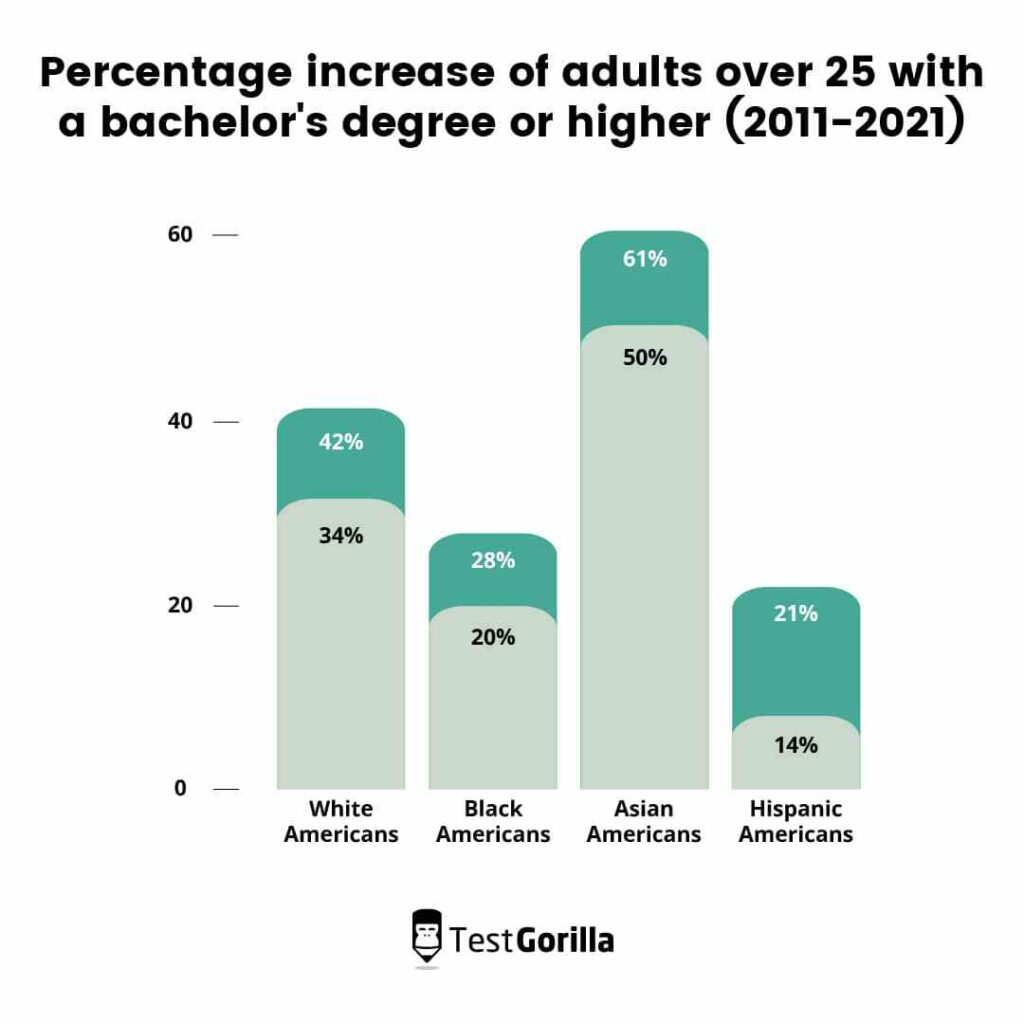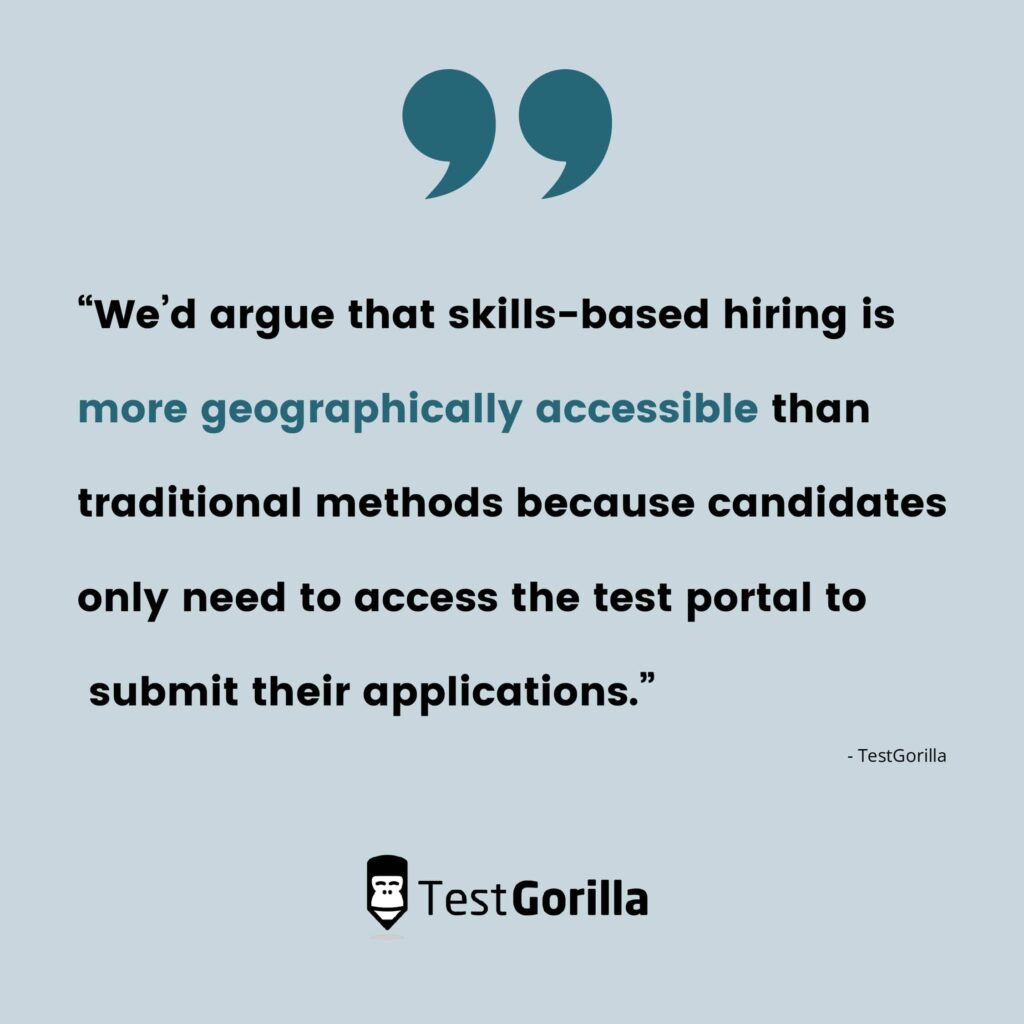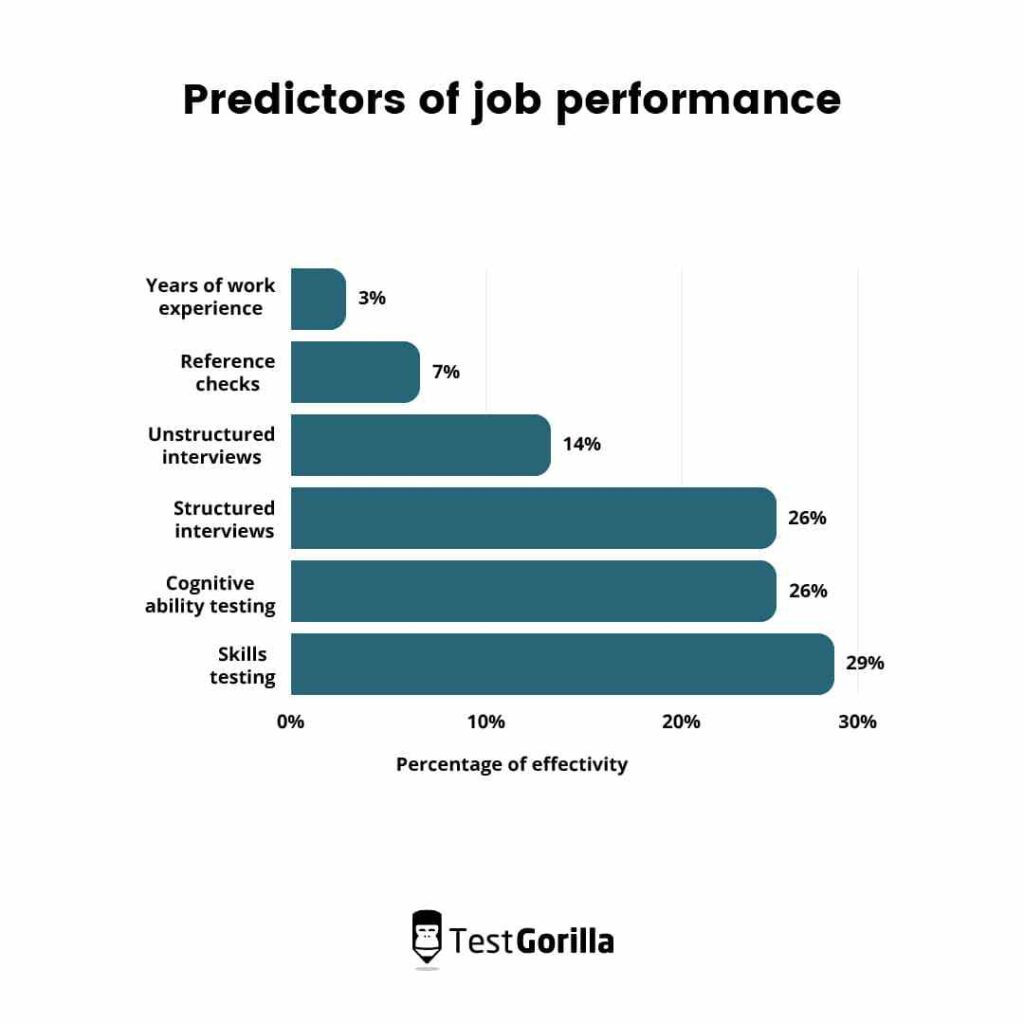5 myths about skills-based hiring busted
The way that companies hire new talent is changing, and it’s about time. After years of box-ticking exercises, cut-and-paste resumes, and skim-read cover letters, businesses worldwide are waking up to the benefits of skills-based hiring.
By soliciting work samples and administering pre-interview testing, employers are empowering candidates to actually show their skills during the hiring process, and it’s delivering results.
In our own State of Skills-Based Hiring 2023 Report, we found that 73% of companies used skills-based hiring to recruit. Over 80% saw reductions in mis-hires and increases in retention and diversity among their employees.
Skills-based hiring could even lead to greater profits. Its benefits for diversity could have knock-on effects on companies’ bottom lines, as Pipeline research found that for every 10% increase in intersectional gender equity, organizations achieve a 1%-2% boost in revenue.[1]
And yet, despite these well-known advantages, there are still leaders who say that skills-based hiring doesn’t match up to traditional methods. They claim that it introduces other biases in hiring or that pre-interview assessments offer candidates an opportunity to cheat the system.
We respectfully disagree.
In this post, we take a deep dive into why myths around skills-based hiring exist and the truth hidden behind each of the most common ones.
Table of contents
Why do myths about skills-based hiring persist?
Like many organizations out there, we believe that skills-based hiring is the future.
That’s a big claim, and asking you to simply write off everything negative you’ve heard about skills-based hiring as a “myth” might seem like a red flag. You might be wondering why the myths persist if they have no basis in fact, but there are a couple of reasons for this.
Reason one: It’s new
Firstly, skills-based hiring is a big change from the normative hiring practices we have known for decades. Throwing out familiar processes like resumes and cover letters often feels uncomfortable to candidates and hiring managers alike. The discomfort created by a big change can sometimes make it seem indistinguishable from a risk.
However, many of today’s most useful business tools also suffered from this phenomenon. Just look at the history of email. It’s hard to even imagine our society operating without email nowadays, but it struggled to get off the ground in the early 1980s.
In fact, a New York Times writer in 1985 even went so far as to call it “no more convenient than the existing alternatives,” such as the postal service or FedEx, and predicted that the very concept of email would wither due to lack of uptake before the technology ever got off the ground.[2]
Skills-based hiring’s comparative newness also means that leaders are naturally hyper-aware of its costs – for instance, the upfront spending involved in employing a pre-employment testing service.
But this attitude overlooks the hidden (or perhaps just widely accepted) costs embedded in current hiring methods, such as the extended time-to-hire resulting from sifting through hundreds of resumes.
According to our State of Skills-Based Hiring Report (linked above), rather than being the expensive hiring option, 89.8% of businesses see a reduction in cost-to-hire due to skills-based hiring.
Reason two: It’s misunderstood
Secondly, even once you get buy-in from leaders, skills-based hiring often presents an issue when it comes to PR within your company. This is because the benefits of skills-based hiring are frequently communicated in a way that threatens professionals’ sense of their own value in their organization.
For example, one of the best-known benefits of skills-based hiring is that it is great at helping organizations overcome unconscious bias.
But this means that when leaders talk about skills-based hiring, they frequently make the mistake of presenting it as a remedy for the personal failings of their teams instead of an improvement to their processes and systems. For example, a leader tells their team that skills-based hiring will eliminate hiring managers’ unconscious bias.
Understandably, individual employees see this as an insult to their skills. Hiring managers might feel they are being accused of overt racism or sexism in their previous hiring decisions. Other employees might think it implies they did not truly deserve their appointment.
It’s not just dominant groups that feel this way but marginalized professionals, too. Indeed, being presented with a “business case for diversity” by a company actually makes marginalized employees report a lower sense of belonging and less motivation to join it.
The good news is that you can resolve these issues with adequate communication and information.
When communicating the value of skills-based hiring to your employees, DEI researcher Lily Zheng recommends focusing on changing flawed systems rather than flawed people – for example, by providing hiring managers with data-driven support during the decision-making process.
Debunking the myths about skills-based hiring
At the end of the day, skills-based hiring is still hiring. You can do nothing to totally remove errors or ensure that a candidate stays for years at your company. However, the most common myths about skills-based hiring blow its limitations way out of proportion and prevent many businesses from enjoying its benefits.
Here are the top five myths about skills-based hiring, debunked.
1. Skills-based hiring unfairly penalizes college graduates
One of the biggest misconceptions about skills-based hiring is that it discriminates against college graduates and knocks them out of the running for roles.
This isn’t entirely true – let us explain.
The number of people getting bachelor’s degrees has boomed since the 2010s. Between 2011 and 2021, the percentage of U.S. adults aged 25 or older with a bachelor’s degree rose from 34% to 42% among white Americans, from 20% to 28% for Black Americans, from 50% to 61% for Asian Americans, and from 14% to 21% for Hispanic Americans.
This rise in the number of bachelor’s degrees awarded coincided with a phenomenon called degree inflation: a boom in demand for bachelor’s degrees in roles that previously didn’t require them, particularly “middle-skill” jobs affected by automation.[3]
Employers were looking for an easy way to tell if a candidate had the necessary technical skills to navigate newly-digitized roles, and degrees were a convenient proxy.
But just checking that a candidate has a degree does not truly verify that they have these skills, nor does it give employers the ability to compare different candidates’ competency in these areas.
This is especially true for roles where the skills required aren’t necessarily ones you must go to university to learn.
Take web development as an example. A survey by HackerRank conducted in 2019 found that JavaScript was the most well-known coding language among professional developers. However, less than half of student developers in 2018 said they knew it.
Not only that, but look back at those stats we quoted above. There are huge racial imbalances when it comes to higher education, which means that filtering candidates by university degree naturally diminishes the diversity of your candidate pool.
All of this to say: Yes, skills-based hiring methods like pre-employment tests might well knock out college grads from the employment process – but only if they lack the skills required for the job.
At the same time, it opens the field to other candidates who have the same skills but come from different backgrounds, widening your talent pool and allowing you to bring a diverse range of thinkers into the fold.
Finally, it allows you to see which candidates have the skills you’re looking for and compare their proficiency in those areas. This makes your hiring managers’ decision-making process easier and more accurate.
2. It’s easy for candidates to manipulate assessments
Another fear that many businesses have when it comes to adopting a skills-based hiring strategy is that it’s easy for candidates to “game the system” if they apply using pre-interview testing. They might do this by:
Asking a friend to take the test for them
Sharing answers with other candidates
Googling the correct answer, either before or during the test
Re-taking the test multiple times
In situational judgment or personality questions, choosing the answer that they think will most appeal to the employer rather than the one that is most honest about how they think or behave
These are, to a certain degree, legitimate concerns. A 2017 study in The Spanish Journal of Psychology found that the percentage of suspected cheaters in the empirical study could be estimated at 13.84% – a non-negligible amount.[4]
However, not all pre-employment tests are created equal. A simple multiple-choice test with answers that can be looked up online is far easier to manipulate than a properly-vetted one created by a reputable organization. At TestGorilla, we’ve worked hard to hone our anti-cheating protocols, and they make a big difference to the accuracy of our tests.
Firstly, the study we cited above was conducted with unproctored internet tests. In other words, the candidates were taking the tests completely unsupervised.
We ask all candidates to keep their webcams on while testing and use a specially-designed anti-cheating monitor to confirm that the right person is completing the assessment and that they are not cheating while they do so – similar to a proctor at an in-person exam.
This reduces manipulation and is less intrusive than an in-person monitor. Further, studies show that proctoring doesn’t negatively affect candidate performance.
We also use many other anti-cheating methods, including (but not limited to):
Cycling questions from each test. Candidates receive only a subset of relevant questions from a much larger question set on each test, and these are rotated from candidate to candidate
Retiring each question after a certain number of uses so that the test stays fresh, even if a question is leaked online
Preventing candidates from registering as test customers by requiring a business address to sign up on our site
Preventing even customers from seeing a full set of test questions so that even if a candidate does slip through the net, they can’t access the answers they’re looking for
But even when we put aside the numerous protocols we’ve developed to prevent cheating on our tests, the fact remains that it’s far easier to manipulate a resume than it is to cheat on a pre-interview assessment. So much so that it’s frequently encouraged by recruiters and other job seekers.
In a 2020 survey of 400 job seekers, Checkster found that 78% had lied,[5] or at least thought about lying, on their resume. Candidates are often encouraged to exaggerate their skill levels, responsibilities, tenure at a previous company, and even their salary to help secure a better position.
The negative impact of this makes itself felt even with complex algorithms in place to screen candidates’ applications, as techniques like “keyword stuffing”[6] ensure that a resume is sent to the top of the pile by algorithms and robots.
If we take this stat as a guide, most resumes are likely to be doctored, while even on an unproctored test, almost 90% of the responses are accurate.
3. Interviews are more accurate than skills-based hiring
Fine, you might think, resumes are no good. But the resume is just a first-round check; the real decision-making happens at the interview.
Sorry to say, but just like resumes, interviews aren’t as reliable as you think they are. At least, not if you’re using the typical unstructured method.
Unstructured interviews, like resumes and cover letters, have gone unchecked for decades as a recruitment method. Interviewers don’t agree on a list of questions or a set of benchmarks beforehand, and they wing it in interviews. This leaves hiring managers with no framework for comparing candidates and opens the door to unconscious bias.
Did you know, for example, that research conducted by Yale University found that even in cases where interviewers received training on objective hiring, both male and female scientists still preferred to hire men?[7]
Still more damning: Google did away with unstructured interviews completely after finding that they only predicted job performance with 14% accuracy. Meanwhile, skills testing was over twice as effective.[8]
Of course, you don’t have to choose just one of these methods in your recruitment process. In reality, you use a combination of these tools.
But by using skills-based hiring methods like pre-interview testing to inform your interview process – and, ideally, taking a structured approach to the latter – your hires can be significantly more successful than when you rely on resumes and unstructured interviews alone.
4. Skills-based hiring isn’t realistic in my industry or region
Perhaps you don’t think skills-based hiring is accessible to your organization, whether because your location is remote, your offices are dispersed around the globe, or your industry is less focused on hard skills like coding.
It’s easy to see how skills testing can help a digital banking company in the UK but less so an education consultancy with offices in 32 countries. But these are both examples from our own clients.
Let’s start with the myth about industry barriers.
Our top-notch test development team creates our tests in collaboration with subject matter experts from across various industries. They are then peer-reviewed by other experts to ensure that questions are up-to-date and accurate to the skills they are assessing.
We have tests on everything, from language proficiency to Python to negotiation. This means that not only can you test for the specialist skills you already have in your team and want to multiply, but you can also fill gaps where skills are missing, and you don’t currently have an in-house expert to assess them, no matter what your industry is.
As for geographical accessibility, we have used our own software to hire 100 people in 31 countries. Our tests can be taken from anywhere in the world, and we offer them in a range of languages, including:
English
Spanish
Dutch
German
French
Italian
Japanese
Portuguese (Brazil)
In fact, we’d argue that skills-based hiring is more geographically accessible than traditional methods because candidates only need to access the test portal to submit their applications. As an employer, you can tailor your search to the specific skill requirements of the role rather than throwing out the one-size-fits-all requirement of a resume and cover letter.
5. Skills-based hiring ultimately leads to bad hires
Finally, the fundamental mistrust underlying all of these myths is the fear that skills-based hiring simply doesn’t work, that it leads to hires who cannot perform their jobs well, do not fit in with the company culture, and do not stick around in the long run.
But that isn’t true. Much of the evidence we’ve already presented supports our view that skills-based hiring is the recruitment method of the future.
We’ve seen that skills testing predicts job performance with greater accuracy than traditional methods and has been adopted by numerous top employers. There is also evidence that skills-tested employees stay longer in their roles: Our State of Skills-Based Hiring Report for 2022 found that voluntary attrition for people recruited using skills-based hiring was 50% lower than those recruited via other approaches.
Our research has additionally shown that skills-based hiring reduces both cost-to-hire and time-to-hire, making it a sure-fire win for hiring teams, and increases access to opportunities for people who exist outside of the traditional corporate mold, whether that’s due to their race, gender identity, education history, or disability status.
Cut through the noise with skills-based hiring
It makes sense to be apprehensive about a big shift in hiring practices. You want to do the best for your business, and throwing out tried-and-tested methods like resumes naturally rings some alarm bells.
What doesn’t make sense, however, is letting that apprehension drown out the real data telling you the myths are all wrong. Skills-based hiring works, and it could be the key to growing your workforce and making it more diverse, efficient, and innovative.
If you don’t know where to start, check out our post on how to adopt skills-based hiring practices.
Sources
“Accenture Makes Strategic Investment in Pipeline to Accelerate Gender Parity in the Workplace”. (August 6, 2021). Accenture. Retrieved January 12, 2023. https://newsroom.accenture.com/news/accenture-makes-strategic-investment-in-pipeline-to-accelerate-gender-parity-in-the-workplace.htm
Sandberg-Diment, Erik. (June 9, 1985). “The Executive Computer; When Technology Outpaces Needs”. The New York Times. Retrieved January 12, 2023. https://www.nytimes.com/1985/06/09/business/the-executive-computer-when-technology-outpaces-needs.html?searchResultPosition=17
Fuller, Joseph; Raman, Manjari. (October 2017). “Dismissed by Degrees”. Harvard Business School. Retrieved January 12, 2023. https://www.hbs.edu/ris/Publication%20Files/dismissed-by-degrees\_707b3f0e-a772-40b7-8f77-aed4a16016cc.pdf
Aguado, David; Vidal, Alejandro; Diaz, Julio Oleo; Ponsoda, Vicente. (December 2018). “Cheating on Unproctored Internet Test Applications: An Analysis of a Verification Test in a Real Personnel Selection Context”. The Spanish Journal of Psychology. Retrieved January 12, 2023. https://www.researchgate.net/publication/329364614\_Cheating\_on\_Unproctored\_Internet\_Test\_Applications\_An\_Analysis\_of\_a\_Verification\_Test\_in\_a\_Real\_Personnel\_Selection\_Context
“Hiring Charlatans?”. Checkster. Retrieved January 10, 2023. https://www.checkster.com/are\_you\_hiring\_charlatans
Hu, James. (October 6, 2021). “Are You Guilty of Resume Keyword Stuffing?”. Jobscan. Retrieved January 5, 2023. https://www.jobscan.co/blog/resume-keyword-stuffing/
Agarwal, Pragya. (December 3, 2018). “Unconscious Bias: How It Affects Us More Than We Know”. Forbes. Retrieved January 5, 2023. https://www.forbes.com/sites/pragyaagarwaleurope/2018/12/03/unconscious-bias-how-it-affects-us-more-than-we-know/?sh=3333fe6e13e7
Bock, Laszlo. (April 2015). “Here’s Google’s Secret to Hiring the Best People”. WIRED. Retrieved January 5, 2023. https://www.wired.com/2015/04/hire-like-google/
Related posts
You've scrolled this far
Why not try TestGorilla for free, and see what happens when you put skills first.
Latest posts
The best advice on pre-employment testing, in your inbox.
No spam. Unsubscribe at any time.

Hire the best. No bias. No stress.
Our screening tests identify the best candidates and make your hiring decisions faster, easier, and bias-free.
Free resources
This checklist covers key features you should look for when choosing a skills testing platform
This resource will help you develop an onboarding checklist for new hires.
How to assess your candidates' attention to detail.
Learn how to get human resources certified through HRCI or SHRM.
Learn how you can improve the level of talent at your company.
Learn how CapitalT reduced hiring bias with online skills assessments.
Learn how to make the resume process more efficient and more effective.
Improve your hiring strategy with these 7 critical recruitment metrics.
Learn how Sukhi decreased time spent reviewing resumes by 83%!
Hire more efficiently with these hacks that 99% of recruiters aren't using.
Make a business case for diversity and inclusion initiatives with this data.





















